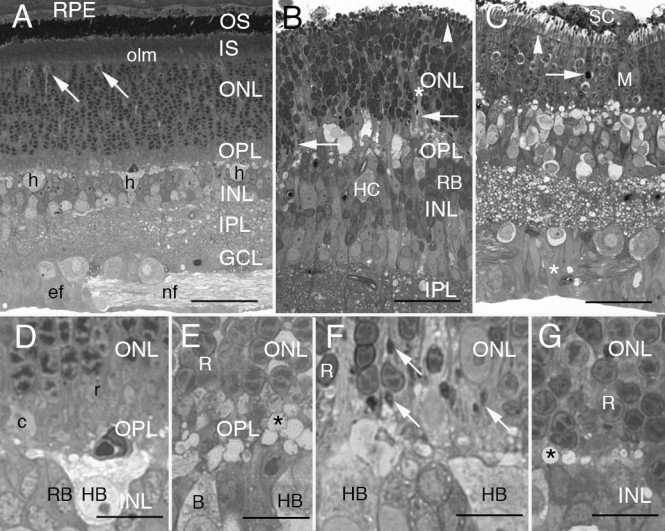Figure 1.
Light micrographs of 0.5 μm-thick resin sections of normal and detached cat retina stained with paraphenylenediamine. A: The layers of this radial section of the posterior, superior temporal region of normal cat retina are labeled to the right. Lipophilic paraphenylenediamine (PPDA) intensely stains the photoreceptor outer segments (OS). Except for the few lightly staining cone nuclei (arrows) just beneath the outer limiting membrane (olm), the 11 or more ranks of nuclei comprising the outer nuclear layer (ONL) are all rods. The outer plexiform layer (OPL) begins where the innermost row of rod nuclei ends and spans to the line of lightly stained horizontal cell somata, 3 of which are shown (h). More proximal still are the inner nuclear (INL), inner plexiform (IPL), and ganglion cell (GCL) layers. Bundles of ganglion cell axons (nf) lie among Müller cell end feet (ef), bordering the retina’s inner limiting membrane. An enlargement of the central region is shown in D. Abbreviations: retinal pigment epithelium (RPE); inner segments (IS). Scale bar represents 40 μm. B: In this slightly oblique section through the posterior, superior nasal region of 7-day detached retina, photoreceptor OS and IS have collapsed and extend just a few micrometers above the olm (white arrowhead). Only 8 to 10 rows of rod nuclei form the ONL, including regions of loosely packed cells (*). The inner margin of this layer is no longer well defined. Many densely stained retracting rod spherules lie in this region (arrows). Most of the lightly stained profiles of varying sizes in the outer OPL are the swollen processes of the B-type horizontal cell (HC). A B-type HC cell body (HB) with its prominent nucleolus lies in the outermost layer of the INL while several rod bipolar cells (RB) cluster to the right. Scale bar represents 35 μm. C: After 28 days of detachment, the ONL of posterior superior temporal retina has only 5 to 7 rows of rod nuclei including one cell shown here undergoing apoptosis (arrow). “Vacuoles” in the OPL are actually swollen processes of the B-type HC. Profiles of retracting spherules, so prominent at 7 days of detachment (B, F), are no longer obvious at 28 days. The Müller cells show dramatic changes including enlargement of the overlapping end feet (*), migration of their nuclei through the outer retina (M), and participation in the formation of a subretinal scar (SC) that spreads out over the photoreceptor layer. Arrowhead indicates olm. Scale bar represents 35 μm. D: The stratified OPL of normal cat retina is shown at higher magnification. This same region is seen in the middle of A. From the top of the figure, the innermost 5 to 6 rows of rod nuclei are densely packed. The outer half of the OPL contains the photoreceptor terminals: several rows of tightly packed rod spherules (r) lie distal to cone pedicles (c). The inner half of the OPL is the neuropil itself. A small capillary containing a red blood cell is transected just above the cell body of a B-type HC (HB) at the outer margin of the INL. RB nuclei also lie in the outer half of the INL. Scale bar represents 10 μm. E: Three days after detachment, the feline outer retina retains much of its typical stratification. Although voids appear among them, rod cell bodies (R) are still closely packed above clustered rod spherules that appear to stain less intensely than normal, but retain their normal size. The underlying neuropil is heavily populated with vacuole-like profiles (*) identified as the swollen branches of hypertrophied HC dendrites and axon telodendria. A portion of an HB shows lightly stained cortical cytoplasm ballooning past the typically dense field of organelles lying near the nucleus. B is an unidentified cone bipolar cell. Scale bar represents 10 μm. F: Disrupted organization of the inner ONL and OPL a week after detachment. The inner ONL has loosely packed rod nuclei (R) separated by thickened Müller cell processes. Large, lightly-staining, ectopic Muller cell nuclei are found here as are the small dark profiles of retracting rod spherules (arrows). Lightly stained HCs have swollen cell bodies (HB). The largely empty cortical cytoplasm extends beyond a diverse field of perinuclear organelles. Pale profiles scattered throughout the OPL are swollen HC processes. Scale bar represents 10 μm. G: Almost a month after detachment, the cell bodies of surviving rods (R) in the ONL directly front on a narrowed OPL neuropil that contains vacuole-like cross-sections of hypertrophied HC processes (*). Though not evident at this magnification, scattered spherules can still be identified by electron microscopy (Figure 4I). Scale bar represents 10 μm.

